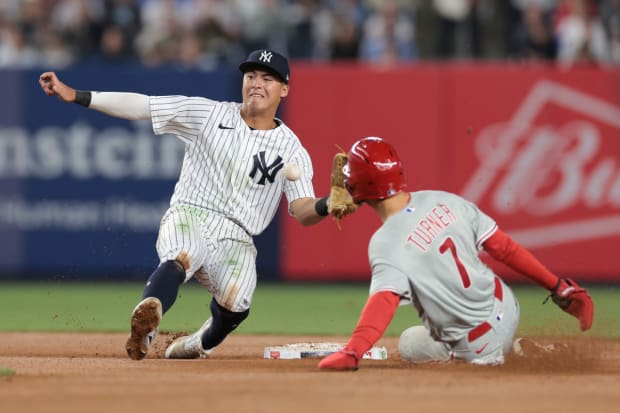The signals from 236 major league games played under the new rules indicate the stolen base environment will have a bigger impact on strategy than the ban on shifts.
It’s much too early to draw conclusions, but there are trends emerging. Batting average on balls in play is up from .290 to .299—which is something, but only enough to bring the game back to where it was in 2017. Balls in play per game are actually down slightly because of increases in the walk and strikeout rates. The shift ban has helped open the game, but maybe not as much as many people (such as lefthanded hitters) expected or hoped.
The bigger change is how easy it has become to steal bases and how often teams are doing it. Among the first impressions:
- Stolen bases are at their highest per-game rate since 1992, when five players stole 50 or more bases. At this rate we will see 1,087 more stolen bases this year than last year, an increase of 44%.
- The stolen base success rate has jumped from 75% to 83%. That should encourage teams to run even more and tailor their roster more to fit this new game.
- Dig deeper into that rate, and you will find that relief pitchers, who often don’t defend the running game as well as starters, are much more vulnerable to steals. Check out these splits:
MLB Stolen Base Success Rate, 2023
vs. Starters |
79% |
vs. Relievers |
88% |
Innings 1–6 |
81% |
Innings 7+ |
86% |
- Relief pitchers are much more difficult to hit than starters (.237 vs. .257 in batting average; .704 vs. .751 in OPS.) When a stolen base attempt carries nearly a 90% success rate late in a game—at a time when stringing hits together becomes more difficult—you should expect more teams to run more often with the game on the line. That adds excitement.
- The steal of third base carries almost no risk. Runners have been successful 48 out of 50 tries, a rate of 96%. Last year it was 76%. As Phillies shortstop Trea Turner pointed out before the season, pitchers, catchers and middle infielders were using PitchCom last year for more pickoff attempts at second base than anybody had ever seen. With the limit of two disengagements from the rubber each plate appearance and less time between pitches, pitchers have lost that luxury and are unable to keep runners as close.
- One piece of advice: Run early in the count. Runners who take off on the first pitch are successful 93% of the time, perhaps figuring that pitchers do not want to burn one of their two pickoff tries before throwing a pitch. When runners wait until two strikes, the success rate drops to 79.5%.
- The Dodgers (23 out of 26 stolen bases allowed), Padres (23 out of 24) and Mets (19 out of 20) have serious problems defending the running game. “We have to be better,” says Padres manager Bob Melvin, who called an actual pitchout Saturday against the Brewers (the runner was not running). The pitchout may actually be coming back.
- Arizona last season was 10–28 vs. Los Angeles and San Diego. This year? They are 6–4 with 17 stolen bases in the six wins.
- Among the seven teams with the most stolen bases are the Guardians, Orioles, Diamondbacks and Pirates. All are young teams playing well, even though only Baltimore among them ranks in the top 10 in slugging.

Vincent Carchietta/USA TODAY Sports
Are stolen bases too easy? I wouldn’t go there yet. Less than one month into the season, the rate of 1.47 stolen bases per game is still less than the entire decade of the 1980s (1.53). But the stolen base environment is changing strategy. For most of the past decade or more, the path to the postseason was a narrow one: you needed power (with rare exceptions such as Cleveland last year). We may be seeing a return to ’80s baseball, when a diversity of styles made the game more interesting and less predictable.
Here’s one more reason to be amazed by Shohei Ohtani.
The amount of spin on the mound keeps going up because it is hard to hit. The average major league hitter slugs 103 points worse against breaking pitches than against fastballs. Ohtani is the rare hitter who slugs higher against breaking pitches.
Among those who have seen at least 1,000 breaking pitches over the past three years, Ohtani is the best slugger against spin at .581, which is higher than his .575 mark against fastballs. (Angels teammate Mike Trout would be the top slugger against spin but does not qualify.)
Drilling down further, Ohtani’s swing arc matches perfectly against the slider, which is the toughest pitch to hit in baseball (.214). Ohtani has hit 23 homers off sliders (including sweepers) since 2021, the most by any lefthanded hitter. Only Pete Alonso has more (27).
Ohtani slugs .607 against sliders, the nastiest pitch that that otherwise yields a .357 slug. Only Yordan Alvarez slugs better against sliders.
Watch MLB live with Fubo: Start a free trial today!
Padres right fielders have hit .170 with no home runs, while the club waits for Fernando Tatis Jr. to return Thursday from his PED suspension. Melvin plans to hit Tatis lead off, in part to allow Juan Soto to see more fastballs by batting him second behind Tatis. Soto has not hit a home run off a breaking pitch since Aug. 28. Since then, he is hitting .130 and slugging .174 against spin. His past six home runs have been hit against fastballs.
Soto is taking more pitches in the strike zone than ever before, while the Padres overall have the lowest swing rate at pitches in the zone. San Diego has used 11 hitting coaches in the past 10 years, including co-hitting coaches Scott Coolbaugh and Ryan Flaherty this year.
The Brewers have improved from 10th in MLB in defensive efficiency to third, trailing only the Twins and Rays. Manager Craig Counsell attributed the defensive upgrade to rookie outfielders Garrett Mitchell and Joey Wiemer, as well as rookie second baseman Brice Turang.
“The three young guys are all excellent defenders,” Counsell said. “Turang is an exceptional defender, Wiemer is a top five defender and Mitchell is excellent, too.”
Only once has a Milwaukee team had three qualified position player rookies: the 1973 Brewers (74–88) with outfielder Bob Coluccio, second baseman Pedro García and shortstop Tim Johnson, who hit .213 with no home runs and the third worst slugging percentage of the live ball era with at least 500 plate appearances (.243). He lost his job the next year to a kid named Robin Yount.







